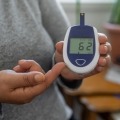Largest Expansion of SNAP in 60 Years is Approved: What this Means for Millions with Diabetes
By Andrew Briskin
 People with diabetes are at a significantly higher risk of facing food insecurity than those without. The recent historic expansion of the Supplemental Nutrition Assistance Program (SNAP) will have the ability to help millions improve their health and become food secure.
People with diabetes are at a significantly higher risk of facing food insecurity than those without. The recent historic expansion of the Supplemental Nutrition Assistance Program (SNAP) will have the ability to help millions improve their health and become food secure.
Due to the economic challenges posed by the COVID-19 pandemic, millions of individuals and families were faced with the impossible decision of choosing between buying food, medication, or paying rent. In response to the economic downturn, the US government expanded funding for the Supplemental Nutrition Assistance Program (SNAP) program, formerly known as food stamps, with a temporary 15% increase in monthly benefits in early 2020.
Due in large part to this intervention, the rate of food insecurity of households in the United States remained unchanged at 10.5% from 2019 to 2020 even with the massive layoffs, wage reductions, and increases in food prices brought on by the pandemic.
“We still need more evidence to confirm this, but I think the plateauing of food insecurity rates represents the incredible success that our programs had in creating new ways for families to afford food,” said Dr. Hilary Seligman, a Professor of Medicine at the University of California San Francisco, specializing in food insecurity and its health implications. “This is an important story because it proves that we know how to eliminate food insecurity in the US and have the infrastructure to continue these efforts.” However, she mentioned, the fact that over one in 10 people still face food insecurity in the US is deeply troubling.
On Oct. 1, the US government passed legislation for the permanent expansion of SNAP benefits. Seligman hoped this expansion will go a long way towards lifting people out of poverty and increasing access to healthy foods.
SNAP is one of the “most successful anti-poverty programs in the US,” she said. “When you give people SNAP benefits, some of the money they would have spent on food can now be used for other necessary expenses. SNAP can also have a tremendous local economic impact, supporting a local food ecosystem and many jobs, buffering the impact felt by these communities during an economic downturn.”
While the temporary increase in benefits from the pandemic were halted at the end of September, the new permanent expansion will increase benefits by an average of 27% compared to pre-pandemic amounts. Depending on your income level and the overall cost of living, this increase will amount to roughly a $12 to $16 increase per person, per month, on top of the current temporary pandemic benefits.
Want to learn more about these permanent SNAP benefit changes? Check out this resource from the US Department of Agriculture or contact your local SNAP office.
What does this mean for people with diabetes?
While this increase may seem modest, it can go a long way, especially for households with children, of which 14.8% were food insecure in 2020. “Along with the increase in benefits, a new policy also allowed households with children to receive the cash value of their school lunches when not in school,” said Seligman. “This gave us the structure to provide meals to kids during any out of school time, including summer vacation, which will likely have a tremendous impact on food insecurity in households with children.” For low income families who have children with diabetes, this can alleviate the stress of finding healthy meals when children are out of school and do not have access to these meals.
An estimated 80 percent of SNAP benefits are spent within the first two weeks after receiving benefits each month, making it very difficult for low income families to purchase healthy foods towards the end of the month. This can also lead to unhealthy habits such as binge eating due to uncertainty about future meals. In fact, there is also evidence suggesting that for low income individuals, the risk of hospital admission due to hypoglycemia is significantly higher in the last week of each month compared to the first week. Given that people with diabetes experience food insecurity at rates almost double the national average, this expansion of benefits could be critical in making sure people have the ability to purchase healthy foods throughout the entire month.
While the permanent expansion of SNAP benefits is a step in the right direction, there is still much more to be done for people and families faced with food insecurity, especially those with diabetes.
“The number one way we can help people with diabetes with food insecurity is to increase SNAP benefits,” said Seligman. “Secondly, we can provide other avenues to access healthy foods for those who are not reached by SNAP benefits. This could include produce prescription programs, food pantries, or home delivered meals. Lastly, we can better educate people on how to manage sick days, or as I prefer to call them, any day when you cannot eat or are eating less than you should for whatever reason.”
If you or someone you know is faced with food insecurity, here are a few resources that can help:
-
SNAP website: which can help determine your eligibility for SNAP benefits
-
Benefits.gov eligibility checker: which can help you access other government benefits related to food and health care
-
NSLP: The National School Lunch Program
-
diaTribe Access Page: Resources for accessing diabetes medication and technology. Additionally, this page includes a search tool on the right-hand side which can help you locate reduced-cost services like food, housing, and medical care in your area.
-
findhelp.org: a free database that has helped millions find free or low-cost food and other essential services in their area
Additionally, if you’re interested in more information about food insecurity and diabetes, check out our articles on the topic:








